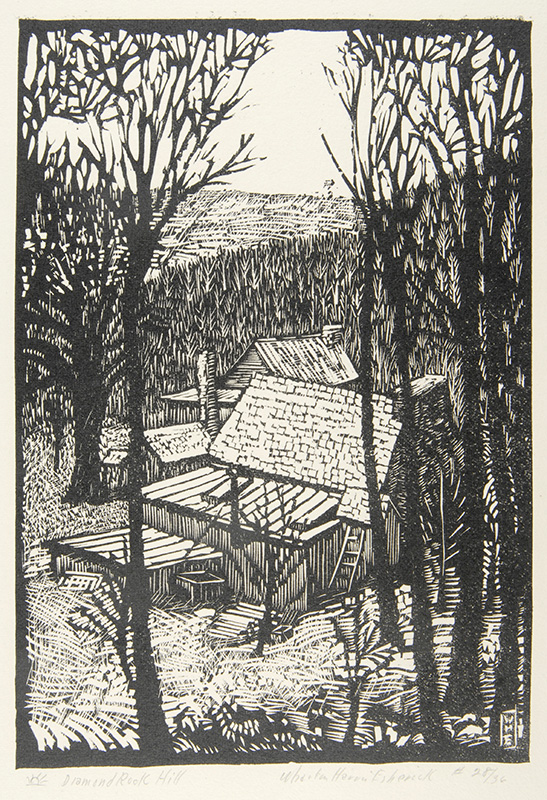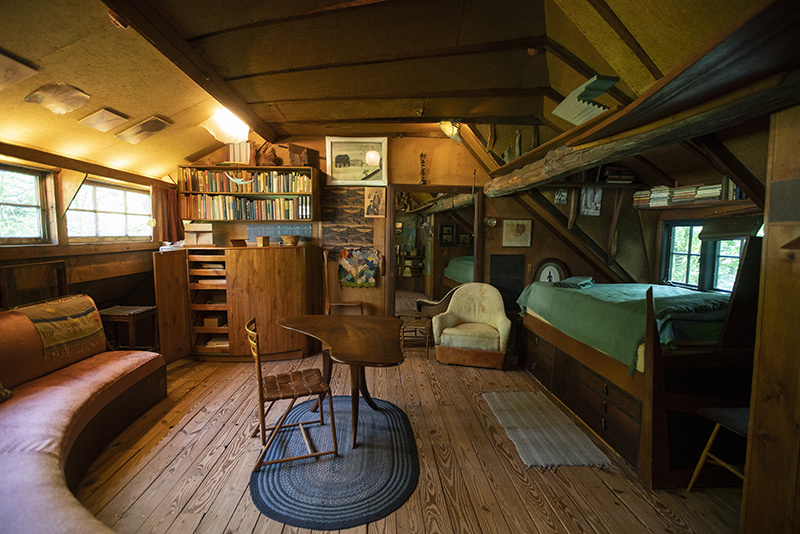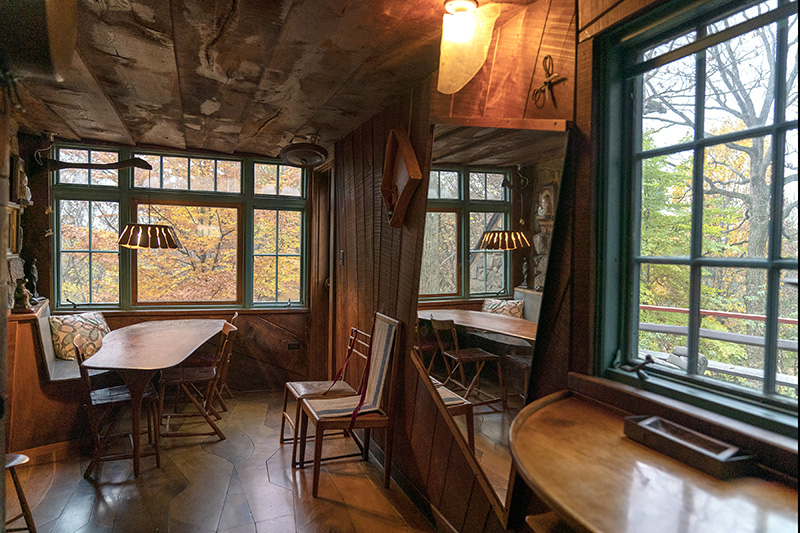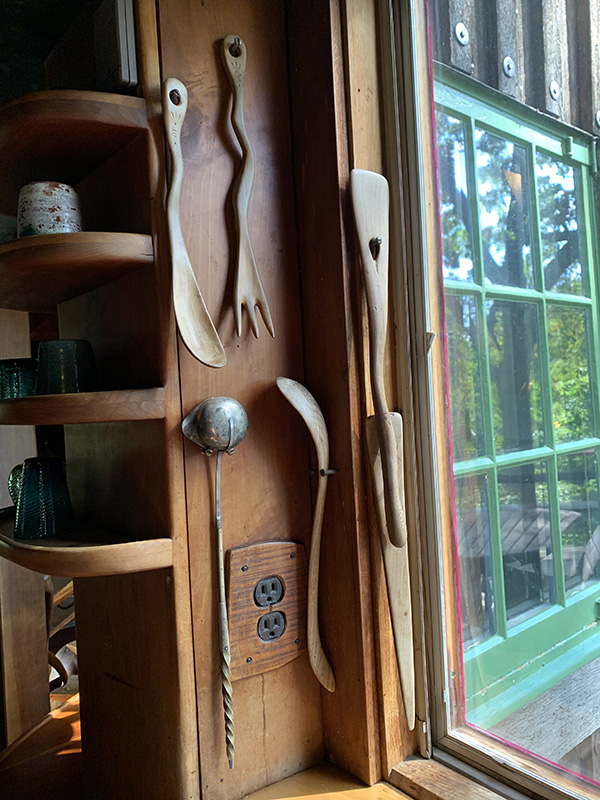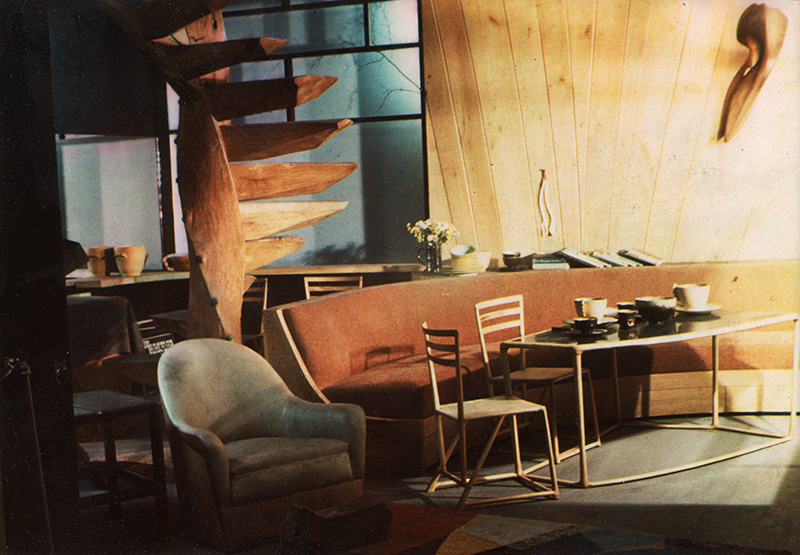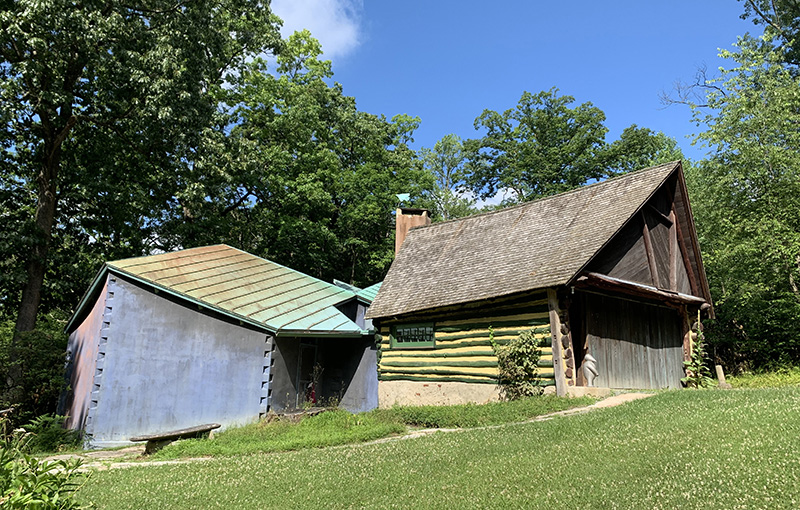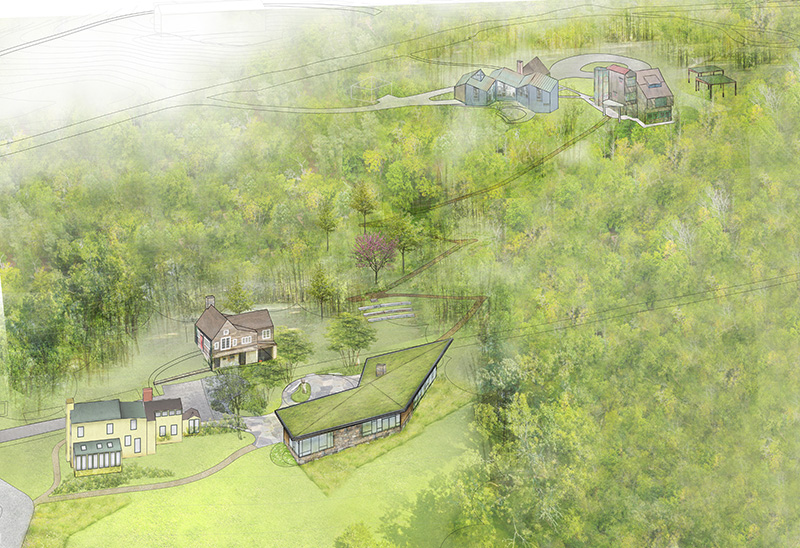A Place That I Think You’ll Like
by Julie Siglin
The story begins with a magnificent cherry tree. Wharton Esherick (1887–1970), an artist often considered the father of the Studio Furniture movement, was recently married and searching for a home in which to start his family. While exploring properties for sale in the Paoli, PA, area with his realtor, the agent said, “I’ll show you a place that I think you’ll like.” As the horses pulled them up the Diamond Rock Hill and rounded a curve, they arrived at an 1800s farmhouse almost dwarfed by an enormous cherry tree. Esherick decided then and there to purchase the property.
Wharton and his wife Leticia “Letty” Nofer had married in Philadelphia in 1912. Prior to their move to the countryside, Esherick dropped out of a two-year scholarship program studying painting at the Pennsylvania Academy of the Fine Arts (PAFA) shortly before graduation. He had become frustrated with formal art education, saying that he was learning to paint like his instructors and wanted to paint like Wharton Esherick instead. He went to work as a commercial illustrator but, upon returning from his three-week honeymoon, was informed that the company had adopted technology that allowed them to print photographic images. Out of a job, he and his new bride decided to leave the city and move to the country.
Wharton and Letty had a bohemian vision for their new life. They planned to live off the land as much as they could, cobble together income, and make what they needed. They lovingly named the farmhouse Sunekrest (pronounced Sunny-crest) and embraced the rural setting, which offered inspiration for Wharton’s landscape paintings and proximity to Philadelphia’s cultural offerings and social connections. In 1916, their first child, Mary, was born. The Eshericks were opposed to sending their children to public schools, fearing that the focus on rote learning and discipline would quash creativity and independent thinking. Attuned to the progressive movements of her day, Letty became aware of Marietta Johnson, founder of the Organic School of Education in Fairhope, AL. Inspired by Johnson’s philosophies, the Eshericks decided to spend 1919–20 in Fairhope to learn more.
With dreams of opening her own Organic School in Paoli, Letty studied with Ms. Johnson while Esherick painted and taught art at the local schools. An exhibition of his paintings was planned at the Organic School, but Esherick realized he had no frames and no place nearby to acquire them. He decided to carve his own, often with iconography that referenced the subject of the painting. These frames were among his first forays into woodworking and garnered more interest and admiration than his paintings alone. By the spring of 1920, Esherick began experimenting with woodcarving and woodblock printmaking (figure 1). By 1926, he and Letty had three children, and Esherick needed space outside of the family home more conducive to woodworking.
In the evenings, he would walk to the top of Diamond Rock Hill and sit under a favorite tree to watch the sun set over the valley. When he learned that this land was for sale, he borrowed funds from his grandmother and purchased the property where the Studio now stands. A nearby quarry offered cast-off stones, too hard for the lime kilns, free of charge, and a local stone mason helped build the structure. They worked without drawings, making decisions on scale and orientation as they went.
Now a National Historic Landmark for Architecture, Esherick’s Studio—and eventual home—is considered a sculptural form to live in, a sentiment that defines Esherick’s broader artistic philosophy (figures 2, 3, 4, and 5). From the structure itself to the carved wooden spoons in the kitchen (figure 6), Esherick considered every surface, angle, and object in his home an opportunity for artmaking. He spent the next 40 years adding to and altering the space with delightful details, including carved latches on the doors (figure 7), hand-forged hinges, and a set of figurative coat pegs depicting the people who helped with the construction of his masterpiece.
Because much of Esherick’s early work was created for his studio and residence, or for Philadelphia-based clients, he remained largely unknown until 1939. Architect George Howe invited him to work on the “Pennsylvania Hill House” interior (figure 8) for the “America at Home” display at the New York World’s Fair, which introduced Esherick to millions of people. The exhibition marked a major transition in Esherick’s career and made him visible to a new generation of artists who would go on to shape the Studio Furniture Movement.
When Esherick passed away in May 1970, his daughter Ruth and her husband, Bob Bascom, along with a group of family and friends, committed themselves to preserving and sharing the Studio and its collections with the public. The Wharton Esherick Museum (WEM) officially opened in September 1972.
Our visitors experience the site as an historic house museum without text panels, ropes, or display cases. We draw on the inherently intimate nature of a structure that was both residence and work space to help our visitors develop a felt-sense of Esherick’s legacy. Visitors are able to access the power of place in physical and ephemeral ways, engage with the artistic process, and transport themselves into Esherick’s imagination.
Our current program space is limited to Esherick’s 1928 Expressionist garage (figure 9). Converted to our Visitor Center in 1993, the 150-square foot space serves as our exhibition space, museum store, and sales desk. While preserving and sharing the site remains our focus, we have begun to utilize our resources differently to prompt creativity in our programming, grow our audience beyond the Studio walls, and cultivate contemporary understanding of Esherick’s life, legacy, and work. Still, our onsite programs remain curtailed by our limited event and exhibition space.
In 2014, the Sunekrest property went back on the market. A generous foundation enabled us to purchase and reunite the two properties, as well as the narratives of Esherick’s early life and artistic evolution. A Master Campus Plan project was initiated by the board and staff of the WEM in 2019 to consider how the two properties could best support our need for mission-driven expansion.
A central question guided our campus planning process: How can the extraordinary vision embodied in Wharton Esherick’s home and studio inspire audiences to act on their creative impulses, and activate his legacy in relevant and inclusive ways? Each year, thousands of individuals identify something in Esherick that encourages them to “get busy” in their own lives and start making things. This effect might be the result of his prolific nature and growth as an artist, his successful experimentation across media and form, his collaborative nature, or his refusal to see hierarchies between art, craft, and design.
Knowing that contemporary artists and makers will be central to our future programming, we consulted with practitioners across a variety of fields whose work resonates with Esherick’s vision. We consulted with colleagues who are successfully activating artist’s homes for deeper creative exploration and community engagement. We also engaged curators and educators who have capitalized on craft’s multi-faceted history and malleable identity, using it to prompt new ways of seeing and creating.
The resulting Master Campus Plan (figure 11) shows restored and renovated historic properties; a welcoming new visitor center with critical collections storage, office, exhibition, and program spaces; and an enchanting, contemplative Ramble through the wooded hillside to connect the upper and lower campus. The plan successfully moves the physical presence of our administration down the hill, further restoring the site to look as it did when Esherick lived and worked there. With additional areas for gathering and programmatic experimentation, the museum can provide deeper connections to Esherick’s legacy to a larger and more diverse community of visitors.
Esherick’s connections to important 20th-century artists remain understudied, and they offer exciting opportunities to scholars. A key building that has traditionally been inaccessible to visitors is an exceptionally rare and important example of the work of internationally renowned architect Louis Kahn (figure 9) that was appended to Escherick’s garage. At PAFA, Esherick studied with such prominent artists as William Merritt Chase, Cecilia Beaux, Edward Redfield, and Childe Hassam. His evolution into a seminal figure in both American Modernism and Studio Craft was shaped by relationships with prominent writers, artists, and authors, including Sherwood Anderson, Jasper Deeter, Theodore Dreiser, Frans Wildenhain, and Henry Varnum Poor.
After 50 years, we now have the opportunity to make the Museum site match the impact of Wharton’s imprint on his field. In late 2020, we were delighted to announce a $10 million endowment gift from the Windgate Foundation. Investment returns from the gift will support our annual operating budget and allow us to invest in our operational capacity.
This endowment gift, coupled with a bold and imaginative Campus Plan, has allowed us to re-envision everything the WEM can be. We have established incredible momentum and hope the transformative gift will inspire the remaining funding we need to create a destination and resource that is commensurate with Esherick’s legacy.
The Wharton Esherick Museum is at a defining moment in its history, becoming a dynamic institution that honors Esherick’s legacy through new and different voices, perspectives, and experiences. We are designing a future that is rooted in the joy of the creative process, and we invite you all to build it with us. We’ll show you a place that we think you’ll like.
Julie Siglin is the WEM’s Executive Director. In August 2021, Julie, Emily Zilber, and Tim Andreadis led a virtual tour of the WEM, which is available on the Decorative Arts Trust’s YouTube channel.
A print version of this article was published in The Magazine of the Decorative Arts Trust, one of our most popular member benefits. Join today!

